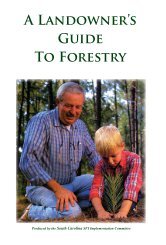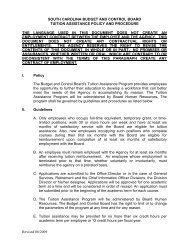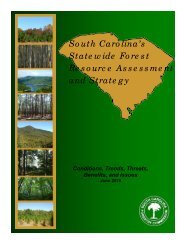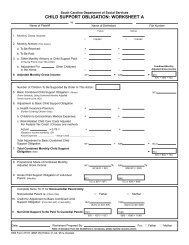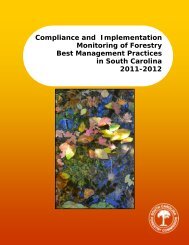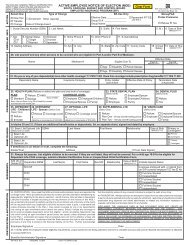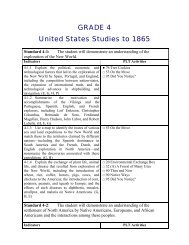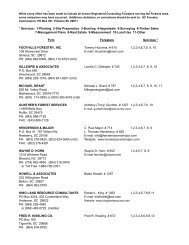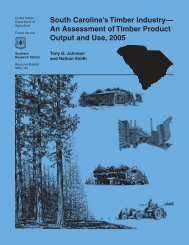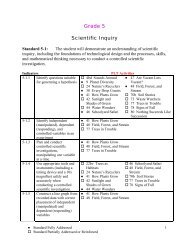Grade 1 Language Arts
Grade 1 Language Arts
Grade 1 Language Arts
Create successful ePaper yourself
Turn your PDF publications into a flip-book with our unique Google optimized e-Paper software.
<strong>Grade</strong> 1<br />
READING<br />
Understanding and Using Literary Texts<br />
Standard 1-1<br />
The student will read and comprehend a variety of literary<br />
texts in print and nonprint formats.<br />
Indicators<br />
1-1.1 Summarize the main idea and<br />
supporting evidence in literary text<br />
during classroom discussion.<br />
1-1.2 Use pictures and words to make<br />
and revise predictions about a given<br />
literary text.<br />
1-1.3 Analyze a narrative text to<br />
determine the narrator.<br />
1-1.4 Find an example of sound<br />
devices (including onomatopoeia and<br />
alliteration) in texts read aloud.<br />
1-1.5 Generate a retelling that<br />
identifies the characters and the<br />
setting in a story and relates the<br />
important events in sequential order.<br />
1-1.6 Explain how elements of<br />
author’s craft (for example, word<br />
choice) affect the meaning of a given<br />
literary text.<br />
1-1.7 Use relevant details in<br />
summarizing stories read aloud.<br />
1-1.8 Create responses to literary<br />
texts through a variety of methods (for<br />
example, writing, creative dramatics,<br />
and the visual and performing arts).<br />
1-1.9 Classify a text as either fiction<br />
or nonfiction.<br />
PLT Activities<br />
4 - Sounds Around<br />
8 - The Forest of S.T. Shrew<br />
18 - Tale of the Sun<br />
87 - Earth Manners<br />
4 - Sounds Around<br />
8 - The Forest of S.T. Shrew<br />
18 - Tale of the Sun<br />
87 - Earth Manners<br />
4 - Sounds Around<br />
8 - The Forest of S.T. Shrew<br />
18 - Tale of the Sun<br />
87- Earth Manners<br />
8 - The Forest of S.T. Shrew<br />
18 - Tale of the Sun
1-1.10 Explain cause-and-effect<br />
relationships presented in literary<br />
text.<br />
1-1.11 Read independently for<br />
extended periods of time for pleasure.<br />
8 - The Forest of S.T. Shrew<br />
18- Tale of the Sun<br />
87- Earth Manners<br />
READING<br />
Understanding and Using Informational Texts<br />
Standard 1-2<br />
The student will read and comprehend a variety of<br />
informational texts in print and nonprint formats.<br />
Indicators<br />
1-2.1 Summarize the central idea and<br />
supporting evidence in an informational<br />
text during classroom discussion.<br />
1-2.2 Analyze informational texts to<br />
draw conclusions and make<br />
inferences during classroom<br />
discussions.<br />
1-2.3 Distinguish between facts and<br />
opinions.<br />
1-2.4 Create responses to<br />
informational texts through a variety of<br />
methods (for example, drawings,<br />
written works, and oral presentations).<br />
1-2.5 Understand that headings,<br />
subheadings, and print styles (for<br />
example, italics, bold, larger type)<br />
provide information to the reader.<br />
1-2.6 Use graphic features (for<br />
example, illustrations, graphs, charts,<br />
and maps) as sources of information.<br />
1-2.7 Use functional text features<br />
(including tables of contents).<br />
1-2.8 Explain cause-and-effect<br />
relationships presented in informational<br />
texts.<br />
1-2.9 Read independently for<br />
extended periods of time to gain<br />
information.<br />
PLT Activities<br />
8- The Forest of S.T. Shrew<br />
8- The Forest of S.T. Shrew<br />
8- The Forest of S.T. Shrew<br />
8- The Forest of S.T. Shrew<br />
16- Pass the Plants, Please<br />
61- The Closer You Look<br />
8- The Forest of S.T. Shrew<br />
87- Earth Manners
READING<br />
Learning to Read<br />
Standard 1-3<br />
The student will learn to read by applying appropriate<br />
skills and strategies.<br />
Indicators<br />
Oral <strong>Language</strong> Acquisition and Vocabulary Development<br />
1-3.1 Use pictures, context, and lettersound<br />
relationships to read unfamiliar<br />
words.<br />
1-3.2 Identify base words and their<br />
inflectional endings (including -s, -es,<br />
-ing, -ed, -er, and -est). (See<br />
Instructional Appendix: Prefixes and<br />
Suffixes.)<br />
1-3.3 Use vocabulary acquired from a<br />
variety of sources (including<br />
conversations, texts read aloud, and<br />
the media).<br />
PLT Activities<br />
1 - The Shape of Things<br />
4 - Sounds Around<br />
8 - The Forest of S.T. Shrew<br />
16 - Pass the Plants, Please<br />
61 - The Closer You Look<br />
79 - Tree Lifecycle – variation<br />
95 - Did You Notice?<br />
1-3.4 Recognize high-frequency<br />
words encountered in texts. (See<br />
Instructional Appendix: High-<br />
Frequency Words.)<br />
1-3.5 Understand the relationship<br />
between two or more words (including<br />
synonyms, antonyms, and<br />
homonyms).<br />
1-3.6 Use structural analysis to<br />
determine the meaning of compound<br />
words and contractions.<br />
Fluency<br />
1-3.7 Use appropriate rate, word<br />
automaticity, phrasing, intonation, and<br />
expression to read fluently.<br />
1-3.8 Use appropriate voice level and<br />
intonation when speaking and reading<br />
aloud.<br />
1 - The Shape of Things<br />
2 - Get on Touch with Trees<br />
8 - The Forest of S.T. Shrew<br />
13 -We All Need Trees<br />
16 - Pass the Plants, Please<br />
21 - Adopt a Tree
Phonemic Awareness<br />
1-3.9 Create rhyming words in<br />
response to an oral prompt.<br />
1-3.10 Create words by orally adding,<br />
deleting, or changing sounds.<br />
1-3.11 Use blending to generate words<br />
orally.<br />
Phonics<br />
1-3.12 Use onsets and rimes to<br />
decode and generate words.<br />
1-3.13 Use knowledge of letter names<br />
and their corresponding sounds to spell<br />
words independently.<br />
1-3.14 Organize a series of words by<br />
alphabetizing to the first letter.<br />
1-3.15 Identify beginning, middle, and<br />
ending sounds in single-syllable words.<br />
1-3.16 Classify words by categories (for<br />
example, beginning and ending<br />
sounds).<br />
1-3.17 Use blending to read.<br />
1-3.18 Spell three- and four-letter shortvowel<br />
words and high-frequency<br />
words correctly. (See Instructional<br />
Appendix: High-Frequency Words.)<br />
1-3.19 Use known words to spell new<br />
words.<br />
Oral <strong>Language</strong> Acquisition and<br />
Comprehension Development<br />
1-3.20 Use pictures and words to<br />
construct meaning.<br />
1-3.21 Recognize environmental print<br />
(for example, signs in the school, road<br />
signs, restaurant and store signs, and<br />
logos).<br />
Concepts about Print<br />
1-3.22 Know the parts of a book<br />
(including the front and back covers,<br />
the title, and the names of the author<br />
and the illustrator).<br />
49 - Tropical Treehouse<br />
95 - Did You Notice?<br />
54 - I’d Like to Visit a Park Where…<br />
8 - The Forest of S.T. Shrew
1-3.23 Carry out left-to-right, top-tobottom,<br />
and return-sweep directionality<br />
on the printed page.<br />
1-3.24 Distinguish among letters,<br />
words, and sentences.<br />
WRITING<br />
Developing Written Communications<br />
Standard 1-4<br />
The student will create written work that has a clear<br />
focus, sufficient detail, coherent organization, effective<br />
use of voice, and correct use of the conventions of<br />
written Standard American English.<br />
Indicators<br />
1-4.1 Generate ideas for writing by<br />
using techniques (for example,<br />
participating in conversations<br />
and looking at pictures).<br />
PLT Activities<br />
8- The Forest of S.T. Shrew<br />
24- Nature’s Recyclers<br />
51- Make Your Own Paper<br />
76- Tree Cookies (variation)<br />
1-4.2 Use simple sentences in writing. 8- The Forest of S.T. Shrew<br />
24- Nature’s Recyclers<br />
51- Make Your Own Paper<br />
1-4.3 Use pictures, letters, or words to<br />
tell a story from beginning to<br />
end.<br />
1-4.4 Use grammatical conventions of<br />
written Standard American English,<br />
including<br />
• personal pronouns,<br />
• common and proper nouns,<br />
• singular and plural nouns, and<br />
• conjunctions (and, but, or).<br />
(See Instructional Appendix:<br />
Composite Writing Matrix.)<br />
1-4.5 Revise for word choice and<br />
simple sentence structure in<br />
written works. (See Instructional<br />
Appendix: Composite Writing<br />
Matrix.)<br />
8- The Forest of S.T. Shrew<br />
24- Nature’s Recyclers
1-4.6 Edit for the correct use of<br />
written Standard American<br />
English, including<br />
• capitalization<br />
– first word of a sentence,<br />
– names of people, and<br />
– pronoun I;<br />
• punctuation<br />
– periods,<br />
– exclamation points, and<br />
– question marks; and<br />
• spelling<br />
- high-frequency words and<br />
- three- and four-letter shortvowel<br />
words.<br />
(See Instructional Appendix:<br />
Composite Writing Matrix.)<br />
1-4.7 Use appropriate spacing<br />
between words.<br />
1-4.8 Use appropriate word formation<br />
by writing from left to right the<br />
letters that spell a word.<br />
1-4.9 Identify sounds orally and in<br />
writing by segmenting words.<br />
WRITING<br />
Producing Written Communications in a Variety of<br />
Forms<br />
Standard 1-5<br />
The student will write for a variety of purposes and<br />
audiences.<br />
Indicators<br />
1-5.1 Create written communications<br />
(for example, thank you notes) for a<br />
specific audience.<br />
1-5.2 Create narratives (for example,<br />
stories and journal entries) about<br />
people, places, actions, or things.<br />
PLT Activities<br />
8 - The Forest of S.T. Shrew<br />
18 - Tale of the Sun<br />
21 - Adopt a Tree<br />
24 - Nature’s Recyclers<br />
46 - Schoolyard Safari<br />
62 - To Be a Tree
1-5.3 Create written pieces that<br />
describe personal experiences, people,<br />
places, or things and that use words<br />
that appeal to the senses.<br />
1-5.4 Create written pieces (for<br />
example, simple rhymes and poems) to<br />
entertain others.<br />
1 - The Shape of Things<br />
8 - The Forest of S.T. Shrew<br />
21 - Adopt a Tree<br />
24 - Nature’s Recyclers<br />
46 - Schoolyard Safari<br />
55 - We Can Work it Out<br />
61 - The Closer You Look<br />
78 - Signs of Fall<br />
RESEARCHING<br />
Applying the Skills of Inquiry and Oral Communication<br />
Standard 1-6<br />
The student will access and use information from a<br />
variety of sources.<br />
Indicators<br />
1-6.1 Generate how and why<br />
questions about a topic of interest.<br />
1-6.2 Use print sources of information<br />
(for example, books, newspapers,<br />
pictures, charts, and graphs) and<br />
nonprint sources to access<br />
information.<br />
1-6.3 Create categories (for example,<br />
plants and animals) to classify<br />
information.<br />
PLT Activities<br />
4 - Sounds Around<br />
8 - The Forest of S.T. Shrew<br />
24 - Nature’s Recyclers<br />
41 - How Plants Grow - variation<br />
51 - Make Your Own Paper<br />
54 - I’d Like to Visit a Park Where…<br />
79 - Tree Lifecycle - variation<br />
78 - Signs of Fall<br />
95 - Did You Notice?<br />
8 - The Forest of S.T. Shrew<br />
16 - Pass the Plants, Please<br />
24 - Nature’s Recyclers<br />
51 - Make Your Own Paper<br />
62 - To Be a Tree<br />
76 - Tree Cookies - variation<br />
79 - Tree Lifecycle - variation<br />
78 - Signs of Fall<br />
2 - Get in Touch with Trees<br />
8 - The Forest of S.T. Shrew<br />
13 -We All Need Trees<br />
16 - Pass the Plants, Please
1-6.4 Use the Internet with the aid of a<br />
teacher.<br />
1-6.5 Use complete sentences when<br />
orally presenting information.<br />
1-6.6 Follow one- and two-step oral<br />
directions.<br />
18 - Tale of the Sun<br />
24 - Nature’s Recyclers<br />
41 - How Plants Grow (variation)<br />
49 - Tropical Treehouse<br />
61 - The Closer You Look<br />
62 - To Be a Tree<br />
79 - Tree Lifecycle - variation<br />
78 - Signs of Fall<br />
1 - The Shape of Things<br />
4 - Sounds Around<br />
51 - Make Your Own Paper<br />
1 - The Shape of Things<br />
4 - Sounds Around<br />
1 - The Shape of Things<br />
2 - Get in Touch with Trees<br />
4 - Sounds Around<br />
8 - The Forest of S.T. Shrew<br />
13 -We All Need Trees<br />
16 - Pass the Plants, Please<br />
18 - Tale of the Sun<br />
21 - Adopt a Tree<br />
24 - Nature’s Recyclers<br />
41 - How Plants Grow (variation)<br />
46 - Schoolyard Safari<br />
51 - Make Your Own Paper<br />
49 - Tropical Treehouse<br />
54 - I’d Like to Visit a Park Where…<br />
55 - We Can Work it Out<br />
61 - The Closer You Look<br />
62 - To Be a Tree<br />
76 - Tree Cookies – variation<br />
77 - Trees in Trouble<br />
78 - Signs of Fall<br />
79 - Tree Lifecycle - variation<br />
87 - Earth Manners



